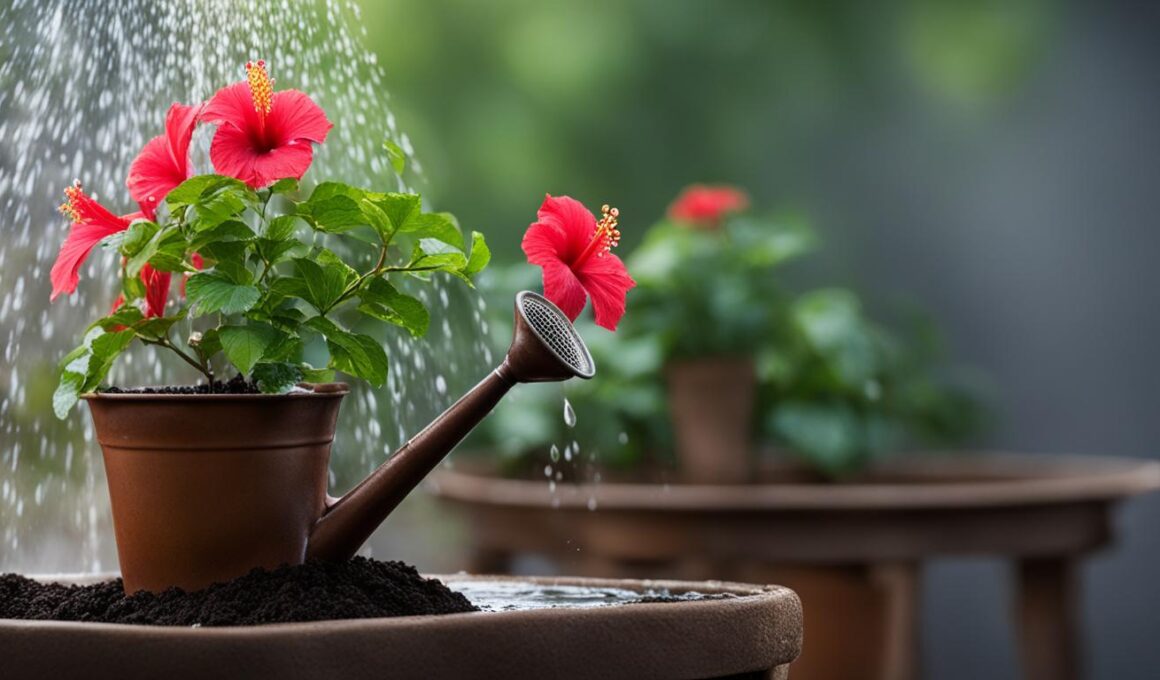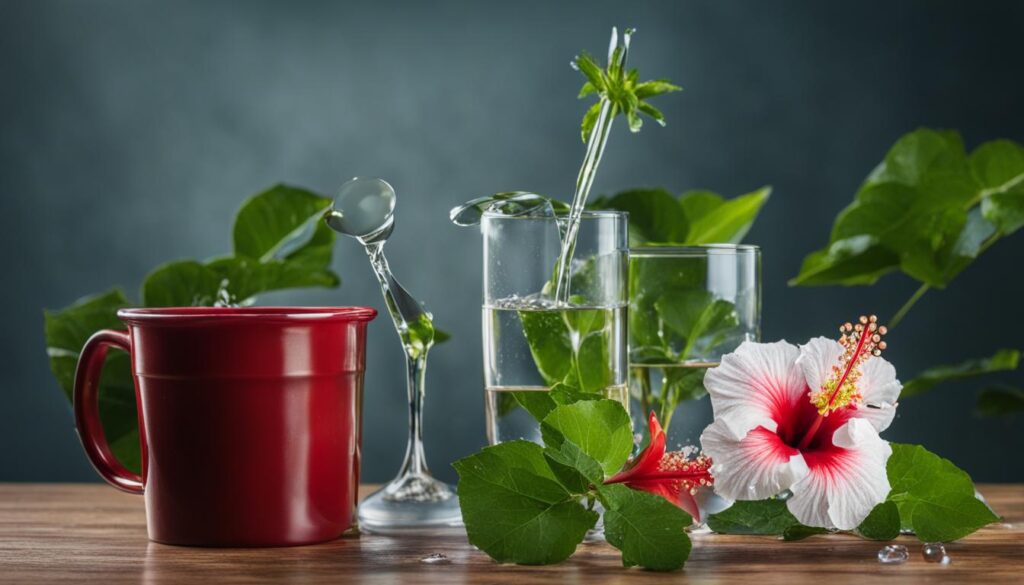Welcome to our guide on caring for your hibiscus plants in pots. If you’re wondering how often to water your hibiscus and want some helpful tips, you’ve come to the right place. Proper watering is essential for the health and vitality of hibiscus plants, ensuring they thrive and produce vibrant blooms. Read on to discover the best practices for watering your hibiscus plants in pots.
Post Summary
- Water hibiscus plants in pots frequently to replicate their natural tropical environment.
- Check the weather conditions and adjust your watering schedule accordingly.
- Water thoroughly, ensuring the soil around the roots is saturated.
- Consider the quality of your water, aiming for a slightly acidic pH level.
- Explore fertigation techniques to provide a steady nutrient supply.
The Water-Loving Nature of Hibiscus
Hibiscus plants are renowned for their water-loving nature. These stunning plants with their large leaves and vibrant, moisture-filled blooms thrive in environments that provide ample water. In their native tropical areas, hibiscus plants receive abundant rainfall and exist in humid conditions, making them well-adapted to water-rich environments.
Comparison of Water Quality for Hibiscus
| Water Source | pH Level | Mineral Content |
|---|---|---|
| Rainwater | 5.5-6.5 | Low |
| Distilled Water | 5.5-6.5 | Low |
| Tap Water | Varies (test with pH kit) | Depends on region |
| Filtered Tap Water (with mineral filter) | 5.5-6.5 (if adjusted) | Low (if adjusted) |
Note: The pH levels and mineral content in tap water may vary depending on your region. Testing your water and consulting local professionals will help you determine the best practice for modifying water conditions for your hibiscus plants.
Watering Before Stress Occurs
One of the key factors in maintaining the health and vitality of your hibiscus plants is preventing water stress. Water stress occurs when the soil or potting mix around the roots of the plants dries out too much, leading to wilting and hindering growth and blooming. To avoid this, it is essential to water your hibiscus plants before they show visible signs of stress. By regularly monitoring the moisture level of the soil and ensuring it does not completely dry out, you can maintain the overall health of your hibiscus plants.
Watering your hibiscus plants before they experience water stress is particularly important during hot weather. High temperatures can rapidly deplete moisture from the soil, causing the plants to become stressed and reducing blooming. By providing sufficient water to maintain consistent moisture levels in the soil, you can prevent wilting and promote healthy growth and abundant flowering.
Remember that the soil should never be allowed to become bone dry before watering. Instead, develop a regular watering routine and aim to keep the soil consistently moist. By paying attention to your hibiscus plants’ watering needs and ensuring they receive adequate moisture before stress occurs, you can help them thrive and enjoy vibrant blooms throughout the growing season.
Signs of Water Stress in Hibiscus Plants
| Signs of Water Stress | Impact on Hibiscus Plants |
|---|---|
| Wilting foliage and flowers | Lack of proper growth and reduced blooming |
| Drooping leaves | Loss of vigor and vitality |
| Yellowing or browning of leaves | Stunted growth and diminished overall health |
| Leaf drop | Loss of foliage and potential plant death |
Watering in Hot Weather
Hot weather can be particularly challenging for hibiscus plants, as it can lead to stress and delay or reduce blooming. To ensure your hibiscus thrives in hot temperatures, it is essential to provide adequate water. During hot days, hibiscus plants, especially those in pots, may require watering twice a day to prevent moisture depletion and maintain vibrant blooms. Watering deeply or using larger pots that can hold more water can also help plants cope with high temperatures.
When watering hibiscus in hot weather, it is crucial to check the moisture level of the soil regularly. Feel the soil with your finger about an inch deep. If it feels dry, it’s time to water. However, if the soil is still moist, you can wait to water until it dries out a bit more. This way, you can avoid overwatering, which can lead to root rot and other problems.
For potted hibiscus in hot weather, it is also important to ensure proper drainage. Make sure your pots have drainage holes to allow excess water to escape. Standing water in pots can suffocate the roots and cause damage to the plant. Additionally, consider using pot saucers filled with water to create a humid microclimate around the plant, helping to maintain moisture levels.
By closely monitoring the moisture levels, providing sufficient water, and creating a suitable environment for your hibiscus plants during hot weather, you can help them thrive and continue to produce beautiful blooms.
Adjusting Watering Frequency According to the Weather
Watering frequency should be adjusted according to current weather conditions. Hotter, drier, sunnier, and windier weather will cause soil and pots to dry out more quickly, necessitating more frequent watering. In contrast, cooler, cloudier, and rainy conditions may require less frequent watering. The goal is to keep the soil consistently moist without becoming waterlogged. A flexible approach to watering based on weather conditions is recommended.
To adapt your watering schedule to the climate, start by monitoring the weather forecast regularly. If the forecast predicts a stretch of hot and dry days, it’s essential to increase the frequency of watering. Check the moisture level of the soil regularly using your finger or a moisture meter. If the top inch of soil is dry, it’s time to water. During periods of intense heat, consider watering in the early morning or late evening when temperatures are cooler. This helps to minimize moisture loss due to evaporation and allows the plants to absorb water more effectively.
In cooler and cloudier weather, reduce the frequency of watering to prevent overwatering and potential root rot. Use the finger or moisture meter test to determine if the soil still has adequate moisture before watering. Additionally, take advantage of natural rainfall by adjusting your watering routine accordingly. If there is significant rainfall, you may need to skip a watering session or two to avoid saturating the soil excessively.
Adapting Watering Routine to Different Climates
The flexibility in your watering routine is crucial, especially if you live in regions with diverse climate patterns. Areas with high humidity or frequent rain may require less frequent watering, while arid regions with low humidity may demand more frequent watering. Take into account your local climate, including average rainfall, humidity levels, and temperature fluctuations, to tailor your watering routine accordingly.
By adjusting your watering frequency according to the weather, you can ensure that your hibiscus plants receive the correct amount of water for optimal health and growth. Remember to strike a balance between providing enough moisture to meet their needs and avoiding waterlogged conditions. With a flexible approach, your hibiscus plants will thrive and reward you with beautiful blooms.
Guidelines for Watering Frequency Based on Temperature
Properly watering your hibiscus plants is essential for their health and longevity. As temperatures fluctuate throughout the year, it’s important to adjust your watering schedule accordingly. By following these guidelines, you can provide your hibiscus plants with the right amount of water to thrive during each season.
Summer Watering Schedule
During the summer months, when temperatures are high, hibiscus plants have increased water needs. As a general rule, hibiscus plants should be watered once per day when temperatures range from the 70s to low-80s Fahrenheit (21-27 degrees Celsius). This ensures that the plants stay hydrated and can cope with the heat.
If temperatures rise into the upper 80s and 90s Fahrenheit (27-32 degrees Celsius), it is recommended to water your hibiscus plants twice per day. This will help prevent moisture depletion and keep the plants healthy and vibrant.
Managing Watering Frequency
If you are unable to water your hibiscus plants twice a day during hot temperatures, there are alternative methods to keep them hydrated. Providing shade for the plants can help reduce moisture loss and decrease the frequency of watering. Additionally, using larger pots with water-filled saucers can create a reservoir of water for the plants to draw from throughout the day.
Another option is to install a drip system controlled by timers. This allows for precise and automated watering, ensuring that your hibiscus plants receive adequate moisture without the need for manual intervention.
| Temperature Range (Fahrenheit) | Watering Frequency |
|---|---|
| 70s to low-80s | Once per day |
| Upper 80s to 90s | Twice per day |
By following these guidelines and adapting your watering routine to the temperature conditions, you can ensure that your hibiscus plants receive the appropriate amount of water to thrive and produce stunning blooms all summer long.
Ensuring Proper Watering Amount
To ensure the health and vitality of your hibiscus plants, it is important to provide them with sufficient water. Proper watering techniques can help prevent wilting, promote growth, and ensure vibrant blooms. Here are some guidelines to help you determine the right amount of water to apply to your hibiscus plants.
When watering your hibiscus, it is crucial to be patient and water each plant thoroughly. Make sure the water soaks all the way through the root zone. For potted hibiscus plants, you can check the moisture level by tipping the plant out of its pot after watering. If the roots are still dry, it indicates that more water is needed.
For hibiscus plants in the ground, digging a shallow well around the plants can help ensure that the water seeps down through the root zone. This helps to prevent runoff and allows the roots to access the moisture they need.
| Watering Guidelines for Hibiscus Plants |
|---|
| Water each plant thoroughly, ensuring the water reaches the root zone. |
| For potted hibiscus, check the moisture level by tipping the plant out of its pot after watering. |
| Dig a shallow well around hibiscus plants in the ground to ensure water reaches the root zone. |
By following these guidelines and ensuring your hibiscus plants receive sufficient water, you can help them thrive and enjoy their beautiful blooms.
Fertigation – Watering Technique for Healthy Hibiscus
Fertigation is a unique watering technique that combines the benefits of watering and fertilizing, providing a steady supply of essential nutrients for hibiscus plants. By incorporating fertigation into your hibiscus care routine, you can optimize their growth and blooming potential.
Combining watering and fertilizing into a single process, fertigation ensures that hibiscus plants receive a continuous and balanced nutrient supply. This technique involves mixing a small amount of fertilizer with the water used for watering the plants. The fertilizer is evenly distributed throughout the soil, allowing the hibiscus roots to absorb the essential nutrients they need.
“Fertigation allows for precise control over the nutrient levels and ensures that hibiscus plants receive a consistent supply of essential elements.”
Fertigation offers several advantages for hibiscus care. Firstly, it promotes healthy growth by delivering nutrients directly to the root zone, where they are most needed. This targeted approach prevents nutrient deficiencies and supports vigorous foliage development and robust blooming. Additionally, fertigation minimizes the risk of nutrient runoff, as the fertilizer is applied in controlled quantities that are readily absorbed by the plants.
Fertigation Guidelines for Hibiscus:
- Use water-soluble fertilizers specifically formulated for flowering plants.
- Dilute the fertilizer according to the instructions provided by the manufacturer.
- Apply the fertilized water to the hibiscus plants during their regular watering schedule.
- Ensure that the fertigation solution reaches the root zone, allowing the plant to absorb the nutrients.
- Monitor the hibiscus plants for any signs of over-fertilization, such as yellowing leaves or stunted growth, and adjust the fertilizer concentration accordingly.
By adopting the fertigation technique for your hibiscus plants, you can enhance their overall health, boost blooming, and enjoy the beauty of vibrant flowers. Remember to follow the guidelines and closely monitor your plants’ response to fertigation, as individual hibiscus varieties may have specific nutrient requirements.
| Advantages of Fertigation for Hibiscus | Disadvantages of Fertigation for Hibiscus |
|---|---|
| 1. Provides a continuous supply of nutrients | 1. Requires accurate fertilizer dilution |
| 2. Enhances plant growth and blooming | 2. Monitoring for over-fertilization is necessary |
| 3. Prevents nutrient deficiencies | 3. Individual hibiscus varieties may have specific nutrient requirements |
| 4. Minimizes nutrient runoff | 4. Initial setup and investment in fertigation equipment may be required |
Conclusion
In conclusion, proper watering is essential for the health and vitality of hibiscus plants in pots. By following these best practices, you can ensure that your hibiscus plants thrive and produce vibrant blooms.
First and foremost, mimicking the water-loving nature of hibiscus is crucial. These plants require ample water, especially during warm and hot weather. Providing frequent and thorough watering will help replicate their natural tropical environment.
Additionally, it is important to adjust your watering frequency based on weather conditions. Hotter and drier weather will require more frequent watering, while cooler and rainier conditions may require less. Remember to keep the soil consistently moist without becoming waterlogged.
Lastly, consider implementing fertigation techniques to provide a steady supply of nutrients to your hibiscus plants. This can be done by combining watering and fertilizing, ensuring continuous nourishment for optimal growth and blooming.
By following these hibiscus watering tips and best practices, you can keep your plants healthy and enjoy their beautiful flowers all season long. Remember to regularly check the moisture levels of the soil and adapt your watering routine accordingly. With proper care and attention, your hibiscus plants will thrive and bring beauty to your garden.
Does the Frequency of Watering for Bonsai Trees Apply to Hibiscus Plants in Pots as Well?
Yes, the frequency of watering your bonsai tree schedule will also apply to hibiscus plants in pots. Just like bonsai trees, hibiscus plants require a consistent watering routine to maintain their health and proper growth. It is important to monitor the soil moisture and adjust the watering frequency accordingly.
FAQ
How often should I water hibiscus plants in pots?
Hibiscus plants in pots should be watered daily, especially during warm and hot weather, unless there has been sufficient rainfall.
How do I determine the amount of water to apply to hibiscus plants?
Thoroughly wet the soil around the roots of hibiscus plants to ensure the water has reached the entire root zone.
What is the ideal water pH for hibiscus plants?
Hibiscus plants prefer slightly acidic water with a pH range of 5.5 to 6.5.
How can I prevent water stress in hibiscus plants?
Water hibiscus plants before they experience visible wilting to maintain their overall health and future growth and blooming.
How should I water hibiscus plants during hot weather?
During hot weather, hibiscus plants, especially those in pots, may require watering twice a day to prevent moisture depletion and maintain vibrant blooms.
Should I adjust the watering frequency according to the weather?
Yes, watering frequency should be adjusted based on current weather conditions. Hotter, drier, sunnier, and windier weather will require more frequent watering, while cooler, cloudier, and rainy conditions may require less watering.
How often should I water hibiscus plants based on temperature?
As a general rule, hibiscus plants should be watered once per day when temperatures range from the 70s to low-80s Fahrenheit (21-27 degrees Celsius). During higher temperatures in the upper 80s and 90s Fahrenheit (27-32 degrees Celsius), watering twice per day is recommended.
How do I ensure proper watering amount for hibiscus plants?
Apply enough water to fully saturate the soil around the roots of hibiscus plants. Checking the moisture level by tipping the plant out of its pot after watering can help determine if enough water has been applied.
What is fertigation and how can it benefit hibiscus plants?
Fertigation is a technique that combines watering and fertilizing, providing a steady supply of nutrients to hibiscus plants. It can be done by mixing fertilizer into the water used for watering hibiscus, ensuring continuous nourishment for optimal growth and blooming.










